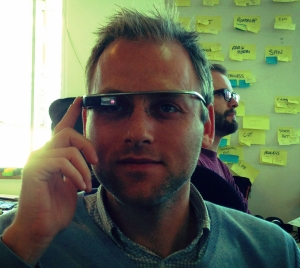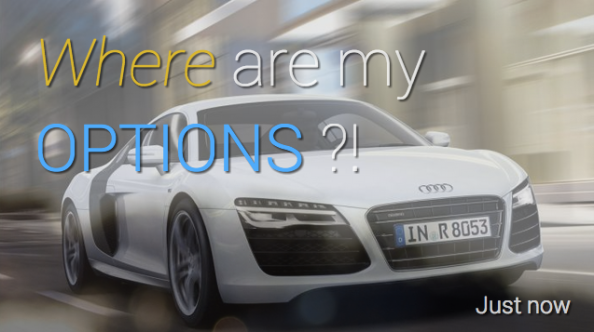We’ve just got our hands on one of two Glass units here at Somo. I’ve had a bit of a play around and thought I would jot down some initial impressions seeing as no one on the internet is talking about Glass…
How does it feel?
Weird. Low-res. High-up in my field of vision. A wee bit sparse. Feels like Google Now for your face. Using it feels ok when you get used to it, but I imagined it to fit into my routine seamlessly so I could stroll along checking out the latest NYT stories – not so, it is very distracting when viewing content and I wouldn’t consider it sensible or safe to carry on your daily business.
Do you like what it looks like?

What. A. Dick.
Do you? I think it looks like a computer on your face, and when the screen is on it looks like your devil-eyes glow red. However, in saying this, I am getting more and more used to seeing it around the office now. I think it looks like a great v1. It really makes this Wired article on wearable tech needing fashion to thrive make a lot more sense.
** EDIT
The ’tilt head up to switch on’ manoeuvre is both ridiculous and hilarious (when other people are doing it, not me). You can’t really use it purely without your hands. At some point you need to touch it, which is annoying seeing as it’s on my face.
How easy is it to use? #speechdetection
It is easy. Even new gestures are pretty simple. The only thing that isn’t that ‘easy’ to use is the speech detection – it’s as good as any Google speech detection, it’s pretty good, but quite a few times it picked up what I was saying incorrectly. Also, it was a surprise to me to get generic search results through when asking Glass to ‘find me a hotel’. I was served with the full search result (not sure if it was PPC or not) including such inspiring copy as “Find cheap hotels, discount hotels and last minute hotel deals at LateRooms.com – theHotel Offers Experts. Book hotels & make hotel reservations online or by ...”. Not cool.
I’m using a shared Glass so have only used a few apps. NYT is pretty impressive as it seems to suit the use case of ‘give me small headline snippets of content’ and it reads them aloud to you so that you don’t focus on the screen for more than a couple of seconds.
**EDIT
The speech detection is pretty annoying actually. Lots wrong. It also reminds me why being conversational, like Siri, or Chrome’s recent conversational search, is important. When asked “how old is Obama?” it told me the correct answer. When I asked “how old is his wife?” it didn’t even register that I was trying to talk with it.
Overall…
It’s fun, new, innovative, unique, but a little limited at the moment. This will no doubt evolve into something really useful over the next year, it just very much seems like a v1 product. If Google had given these units out for free, or very cheap, then it would be awesome and completely worth it, however, paying $1,500 for one at the moment isn’t hugely worthwhile.
Will this replace my mobile? No chance. Our phones are really sophisticated, powerful devices that offer everything from 10 times a day utility, through to Plants Vs Zombies. My iPhone offers me far too many rich, thoroughly thought-out, reliable experiences that I fear Glass, or wearable tech sans-smartphone, will take years to match. I see Glass as a very ‘top-level’ gadget – something to give you a snapshot of info – where phones will remain the device of choice for longer, more in-depth experiences.

